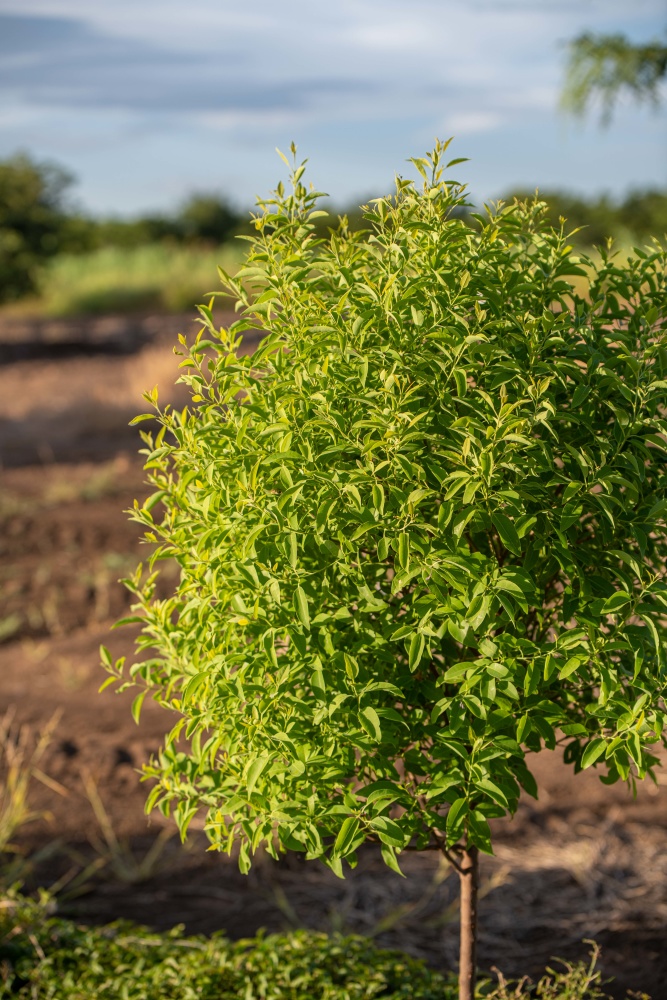Sandalwood (Santalum album)
- Family: Santalaceae
- Local Names: English (sandalwood tree,sandalwood,coastal sandalwood), French (bois de santal), Hawaian (iliahialo‘e), Spanish (sándalo)
Description
1. Santalum ellipticum is a sprawling shrub to small tree, 1–5 m tall and 1–3 m in canopy diameter, maximally reaching 12 m tall and 5 m in canopy diameter, and bole diameter at breast height (dbh) of 30 cm. The species forms an extensive network of surface roots capable of grafting onto roots of other species that serve as a source of water and mineral nutrients.
2. Leaves elliptic to orbicular, ovate, or obovate and leathery to succulent; 2.5–6.1 cm long and 1.7–4 cm wide, with petioles up to 15 mm long; dull, grayish green, with glaucous upper and lower surfaces.
3. Inflorescence greenish tinged with brown, or orange, produced in terminal compound cymes. Pedicels 0–1 mm long, the floral tube campanulate to conical, 4–7 mm long, with an inferior ovary. Flowers produce a sweet fragrance.
4. Fruits purple to black drupes, often glaucous, 9–12 mm long, with a distinctive apical receptacular ring. The kernels consist of a hard, woody, smooth or slightly rough, lightcolored endocarp enclosing a single seed.
Ecology
1. Santalum ellipticum grows near the ocean shore, in dry gulches, on slopes or ridges, and frequently in rocky habitats. The species also grows in arid shrub land and forest, often persisting in areas invaded by nonnative species. Associated species include Wikstroemia sandwicensis and the Nihoa Island fan palm Pritchardia remota in windward, lowland areas. In more dry environments S. ellipticum is associated with Chenopodium oahuense and Chamaesyce hypericifolia.
2. Coastal sandalwood can survive with up to 60–70% shade, with growth rates slower at higher shade levels. The optimum level of shade is up to about 25%, preferably as side shade.
3. Sandalwood species generally have a capacity for invasiveness in disturbed, more open plant communities. This is not considered a problem because of their very high value, their small stature, and the fact that they do not appear to modify such communities in any substantial way. Being parasitic, importation of viable Santalum seed into the U.S. (including Hawai‘i) is prohibited by federal law.
Native range
India
Tree Management
1. Seedlings are ready for out planting after about 6 months when height is about 20–25 cm.
2. Planting should be among established long term host plants or together with intermediate hosts while longer term hosts are established. For high survival rates planting should be at the onset of the rainy season and be kept well weeded in the first 2 years.
3. Spacing for commercial production should vary depending on type of planting. The final crop should be around 100 mature trees per hectare due to the need to include host tree/shrub species (at a rate of 2–4 per sandalwood trees depending on host species).
Timber
Sandalwood is used for carving religious statues and objects, handicrafts, art, and decorative furniture, musical instruments and canoe construction.
Shade or Shelter
Medicine
A shampoo made from a leaf infusion was used for curing dandruff and eliminating head lice. A drink made from finely ground powdered heartwood, mixed with other plants, followed by laxative was used in curing diseases of both male and female sex organs
Gum or Resin


